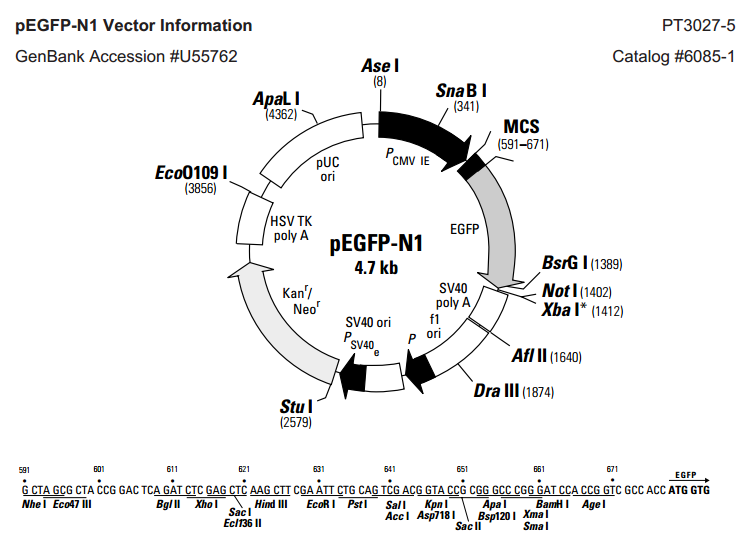pEGFP-N1哺乳荧光质粒

| 目录号 | 规格 | 价格 | 是否现货 |
|---|---|---|---|
| YP0133 | 1ug | 780 | 有货 |
基本信息
别名: | pEGFPN1 |
启动子: | CMV |
复制子: | pUC |
终止子: | SV40 poly(A) signal |
质粒分类: | 哺乳系列质粒;哺乳荧光质粒;哺乳绿色质粒 |
质粒大小: | 4733bp |
质粒标签: | C-EGFP |
原核抗性: | Kan |
真核抗性: | G418 |
克隆菌株: | DH5a |
培养条件: | 37℃,有氧,5%CO2 |
表达宿主: | 293T等哺乳细胞 |
诱导方式: | 无须诱导,瞬时表达 |
| 5'测序引物: | pEGFP-N-5:TGGGAGGTCTATATAAGCAGAG |
3'测序引物: | pEGFP-N-3:CGTCGCCGTCCAGCTCGACCAG |
质粒属性
质粒宿主: | 哺乳细胞 |
质粒用途: | 蛋白表达 |
片段类型: | ORF |
片段物种: | 空载体 |
原核抗性: | Kan |
真核抗性: | G418 |
荧光标记: | 绿色 |
质粒简介
pEGFP-N1 encodes a red-shifted variant of wild-type GFP which has been optimized for brighter fluorescence and higher expression in mammalian cells. (Excitation maximum = 488 nm; emission maximum = 507 nm.) pEGFP-N1 encodes the GFPmut1 variant which contains the double-amino-acid substitution of Phe-64 to Leu and Ser-65 to Thr. The coding sequence of the EGFP gene contains more than 190 silent base changes which correspond to human codon-usage preferences. Sequences flanking EGFP have been converted to a Kozak consensus translation initiation site to further increase the translation efficiency in eukaryotic cells. The MCS in pEGFP-N1 is between the immediate early promoter of CMV and the EGFP coding sequences. Genes cloned into the MCS will be expressed as fusions to the N-terminus of EGFP if they are in the same reading frame as EGFP and there are no intervening stop codons. SV40 polyadenylation signals downstream of the EGFP gene direct proper processing of the 3' end of the EGFP mRNA. The vector backbone also contains an SV40 origin for replication in mammalian cells expressing the SV40 T antigen. A neomycin-resistance cassette, consisting of the SV40 early promoter, the neomycin/kanamycin resistance gene of Tn5, and polyadenylation signals from the Herpes simplex virus thymidine kinase (HSV TK) gene, allows stably transfected eukaryotic cells to be selected using G418. A bacterial promoter upstream of this cassette expresses kanamycin resistance in E. coli. The pEGFP-N1 backbone also provides a pUC origin of replication for propagation in E. coli and an f1 origin for single-stranded DNA production.
Fusions to the N terminus of EGFP retain the fluorescent properties of the native protein allowing the localization of the fusion protein in vivo . The target gene should be cloned into pEGFP-N1 so that it is in frame with the EGFP coding sequences, with no intervening in-frame stop codons. The inserted gene should include the initiating ATG codon. The recombinant EGFP vector can be transfected into mammalian cells using any standard transfection method. If required, stable transformants can be selected using G418 . pEGFP-N1 can also be used simply to express EGFP in a cell line of interest (e.g., as a transfection marker).
质粒图谱

质粒序列
质粒序列请下载:
